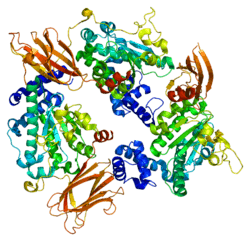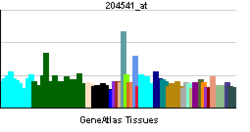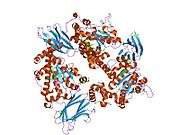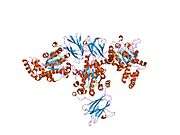SEC14L2
SEC14-like protein 2 is a protein that in humans is encoded by the SEC14L2 gene.[3][4]
Function
This gene encodes a cytosolic protein which belongs to a family of lipid-binding proteins including Sec14p, alpha-tocopherol transfer protein, and cellular retinol-binding protein. The encoded protein stimulates squalene monooxygenase which is a downstream enzyme in the cholesterol biosynthetic pathway.[4]
References
- ↑ "Human PubMed Reference:".
- ↑ "Mouse PubMed Reference:".
- ↑ Dunham I, Shimizu N, Roe BA, Chissoe S, Hunt AR, Collins JE, Bruskiewich R, Beare DM, Clamp M, Smink LJ, Ainscough R, Almeida JP, Babbage A, Bagguley C, Bailey J, Barlow K, Bates KN, Beasley O, Bird CP, Blakey S, Bridgeman AM, Buck D, Burgess J, Burrill WD, O'Brien KP (Dec 1999). "The DNA sequence of human chromosome 22". Nature. 402 (6761): 489–95. doi:10.1038/990031. PMID 10591208.
- 1 2 "Entrez Gene: SEC14L2 SEC14-like 2 (S. cerevisiae)".
Further reading
- Caras IW, Friedlander EJ, Bloch K (1980). "Interactions of supernatant protein factor with components of the microsomal squalene epoxidase system. Binding of supernatant protein factor to anionic phospholipids". J. Biol. Chem. 255 (8): 3575–80. PMID 7364757.
- Maruyama K, Sugano S (1994). "Oligo-capping: a simple method to replace the cap structure of eukaryotic mRNAs with oligoribonucleotides". Gene. 138 (1–2): 171–4. doi:10.1016/0378-1119(94)90802-8. PMID 8125298.
- Solheim JC, Harris MR, Kindle CS, Hansen TH (1997). "Prominence of beta 2-microglobulin, class I heavy chain conformation, and tapasin in the interactions of class I heavy chain with calreticulin and the transporter associated with antigen processing". J. Immunol. 158 (5): 2236–41. PMID 9036970.
- Suzuki Y, Yoshitomo-Nakagawa K, Maruyama K, Suyama A, Sugano S (1997). "Construction and characterization of a full length-enriched and a 5'-end-enriched cDNA library". Gene. 200 (1–2): 149–56. doi:10.1016/S0378-1119(97)00411-3. PMID 9373149.
- "Toward a complete human genome sequence". Genome Res. 8 (11): 1097–108. 1999. doi:10.1101/gr.8.11.1097. PMID 9847074.
- Hirosawa M, Nagase T, Ishikawa K, Kikuno R, Nomura N, Ohara O (2000). "Characterization of cDNA clones selected by the GeneMark analysis from size-fractionated cDNA libraries from human brain". DNA Res. 6 (5): 329–36. doi:10.1093/dnares/6.5.329. PMID 10574461.
- Zimmer S, Stocker A, Sarbolouki MN, Spycher SE, Sassoon J, Azzi A (2000). "A novel human tocopherol-associated protein: cloning, in vitro expression, and characterization". J. Biol. Chem. 275 (33): 25672–80. doi:10.1074/jbc.M000851200. PMID 10829015.
- Shibata N, Arita M, Misaki Y, Dohmae N, Takio K, Ono T, Inoue K, Arai H (2001). "Supernatant protein factor, which stimulates the conversion of squalene to lanosterol, is a cytosolic squalene transfer protein and enhances cholesterol biosynthesis". Proc. Natl. Acad. Sci. U.S.A. 98 (5): 2244–9. doi:10.1073/pnas.041620398. PMC 30123
 . PMID 11226224.
. PMID 11226224.
- Hirosawa M, Nagase T, Murahashi Y, Kikuno R, Ohara O (2001). "Identification of novel transcribed sequences on human chromosome 22 by expressed sequence tag mapping". DNA Res. 8 (1): 1–9. doi:10.1093/dnares/8.1.1. PMID 11258795.
- Yamauchi J, Iwamoto T, Kida S, Masushige S, Yamada K, Esashi T (2001). "Tocopherol-associated protein is a ligand-dependent transcriptional activator". Biochem. Biophys. Res. Commun. 285 (2): 295–9. doi:10.1006/bbrc.2001.5162. PMID 11444841.
- Stocker A, Tomizaki T, Schulze-Briese C, Baumann U (2003). "Crystal structure of the human supernatant protein factor". Structure. 10 (11): 1533–40. doi:10.1016/S0969-2126(02)00884-5. PMID 12429094.
- Singh DK, Mokashi V, Elmore CL, Porter TD (2003). "Phosphorylation of supernatant protein factor enhances its ability to stimulate microsomal squalene monooxygenase". J. Biol. Chem. 278 (8): 5646–51. doi:10.1074/jbc.M211750200. PMID 12454003.
- Kempná P, Zingg JM, Ricciarelli R, Hierl M, Saxena S, Azzi A (2004). "Cloning of novel human SEC14p-like proteins: ligand binding and functional properties". Free Radic. Biol. Med. 34 (11): 1458–72. doi:10.1016/S0891-5849(03)00173-4. PMID 12757856.
- Stocker A, Baumann U (2003). "Supernatant protein factor in complex with RRR-alpha-tocopherylquinone: a link between oxidized Vitamin E and cholesterol biosynthesis". J. Mol. Biol. 332 (4): 759–65. doi:10.1016/S0022-2836(03)00924-0. PMID 12972248.
- Mokashi V, Singh DK, Porter TD (2004). "Rat supernatant protein factor-like protein stimulates squalene monooxygenase and is activated by protein kinase A". Biochem. Biophys. Res. Commun. 316 (3): 688–92. doi:10.1016/j.bbrc.2004.02.103. PMID 15033454.
- Collins JE, Wright CL, Edwards CA, Davis MP, Grinham JA, Cole CG, Goward ME, Aguado B, Mallya M, Mokrab Y, Huckle EJ, Beare DM, Dunham I (2005). "A genome annotation-driven approach to cloning the human ORFeome". Genome Biol. 5 (10): R84. doi:10.1186/gb-2004-5-10-r84. PMC 545604
 . PMID 15461802.
. PMID 15461802.
- Cheng J, Kapranov P, Drenkow J, Dike S, Brubaker S, Patel S, Long J, Stern D, Tammana H, Helt G, Sementchenko V, Piccolboni A, Bekiranov S, Bailey DK, Ganesh M, Ghosh S, Bell I, Gerhard DS, Gingeras TR (2005). "Transcriptional maps of 10 human chromosomes at 5-nucleotide resolution". Science. 308 (5725): 1149–54. doi:10.1126/science.1108625. PMID 15790807.
PDB gallery |
|---|
|
| 1o6u: THE CRYSTAL STRUCTURE OF HUMAN SUPERNATANT PROTEIN FACTOR |
| 1olm: SUPERNATANT PROTEIN FACTOR IN COMPLEX WITH RRR-ALPHA-TOCOPHERYLQUINONE: A LINK BETWEEN OXIDIZED VITAMIN E AND CHOLESTEROL BIOSYNTHESIS |
|
|


 . PMID 11226224.
. PMID 11226224. . PMID 15461802.
. PMID 15461802.
